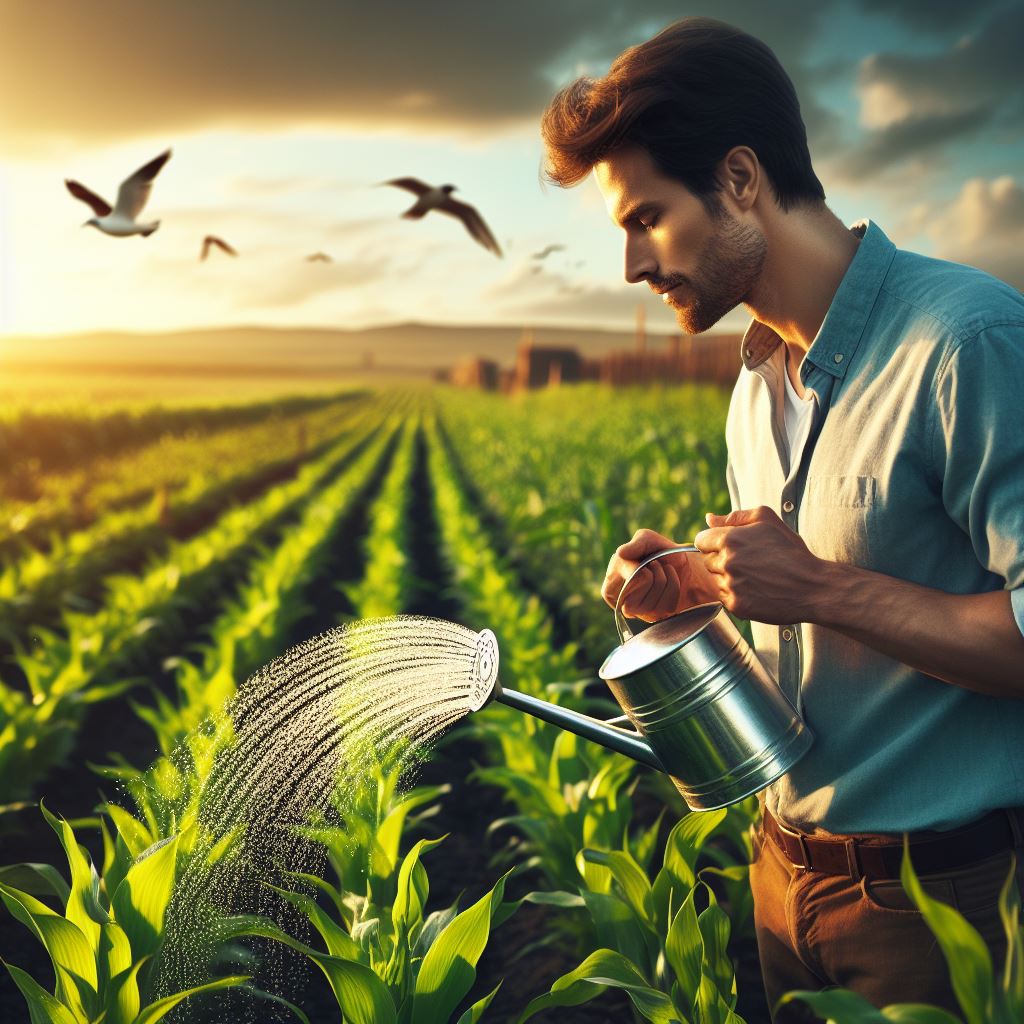Introduction
Water laws play a pivotal role in shaping the landscape of agriculture in the United States.
With the growing concerns over water scarcity and environmental sustainability, these laws are becoming increasingly important in regulating water usage for crop growth.
The significance of water laws lies in their ability to ensure equitable access to water resources, promote efficient irrigation practices, and safeguard the environment.
Through regulatory frameworks and enforcement mechanisms, water laws establish guidelines for water allocation, usage, and conservation in agriculture.
They aim to balance the needs of various stakeholders, including farmers, communities, and ecosystems, while addressing competing demands for water.
Furthermore, water laws encourage the adoption of water-efficient technologies and practices, such as drip irrigation and soil moisture monitoring, to optimize water use efficiency in crop production.
By promoting sustainable water management strategies, these laws contribute to the resilience and long-term viability of agricultural systems.
As water resources face increasing pressure from climate change and population growth, the role of water laws in regulating water usage for agriculture will continue to grow in importance.
It is essential for farmers and policymakers alike to understand and adhere to these laws to ensure the sustainability of crop growth and the overall health of agricultural ecosystems.
Background of Water Laws in the US
Water laws in the United States have a long history and have evolved over time to address the various challenges associated with water management in the country.
A. History and development of water laws in the US
- The first water laws in the US date back to the mid-19th century, during the era of westward expansion.
- These laws were primarily focused on water rights and were influenced by the doctrine of prior appropriation.
- The doctrine of prior appropriation granted water rights to those who were the first to use water for beneficial purposes.
- As the population grew and water demands increased, the need for more comprehensive water laws became evident.
- The development of large-scale irrigation projects, such as the Hoover Dam, also necessitated the establishment of federal water regulations.
- The Federal Water Pollution Control Act of 1948, later renamed the Clean Water Act, was one of the key milestones in water law history.
- This legislation aimed to protect and restore the quality of the nation’s waters and regulate the discharge of pollutants into water bodies.
- The development of water law in the US has been a complex process involving collaboration between federal, state, and local governments.
- State water laws vary considerably across the country due to differing water availability, needs, and priorities.
- Today, water laws in the US continue to evolve as new challenges, such as climate change and increased demand, emerge.
B. Objective of water laws in ensuring sustainable water management
- The primary objective of water laws in the US is to ensure sustainable water management.
- These laws aim to balance competing water uses, protect water resources, and promote efficient allocation of water.
- By establishing legal frameworks and regulations, water laws help prevent overuse and depletion of water sources.
- They also promote conservation, encourage water reuse and recycling, and support the development of water-efficient technologies.
- Through the establishment of water rights and permitting systems, water laws provide a framework for allocating water among users.
- Water laws also play a crucial role in resolving conflicts over water resources and ensuring equitable access for all stakeholders.
C. Key federal water regulations impacting crop growth
Several federal water regulations directly impact crop growth in the United States:
- The Clean Water Act regulates the discharge of pollutants into water bodies, protecting water quality for irrigation purposes.
- The Endangered Species Act protects species, such as fish, which rely on water habitats and can affect agricultural water use.
- The Safe Drinking Water Act ensures the quality and safety of water supplies used for irrigation and pesticide application.
- The National Environmental Policy Act requires federal agencies to consider the environmental impacts of their actions, including water-related projects.
- The Federal Insecticide, Fungicide, and Rodenticide Act regulates the use of pesticides in agriculture, addressing potential water contamination issues.
Overall, water laws in the United States play a critical role in ensuring sustainable water management and have significant impacts on crop growth and agricultural practices.
Read: Wildlife Protection and Farm Lands
Key Factors Impacting Crop Growth
A. Water scarcity and drought conditions in certain regions
Water scarcity and drought conditions in certain regions have a profound effect on crop growth.
When there is a shortage of water, crops suffer and their overall yield and quality decline.
Transform Your Agribusiness
Unlock your farm's potential with expert advice tailored to your needs. Get actionable steps that drive real results.
Get StartedB. Clean Water Act and its influence on water quality standards
The Clean Water Act has been a crucial legislation in preserving and improving water quality standards in the United States.
It has played a significant role in reducing water pollution, which is known to negatively influence crop health and productivity.
Proper water quality is essential for sustaining healthy crops.
C. Agricultural Water Management Practices
Agricultural water management practices are vital in ensuring optimal crop growth.
Efficient irrigation techniques are critical for providing crops with sufficient water while minimizing waste.
Techniques such as drip irrigation or precision sprinklers help deliver water directly to plants’ roots, reducing water loss through evaporation and runoff.
In addition to efficient irrigation, water conservation practices significantly impact crop growth and water usage.
Implementing conservation methods like rainwater harvesting, soil moisture monitoring, and crop rotation can help reduce water usage and improve crop yields.
These practices focus on maximizing the use of available water resources and optimizing crop growth while minimizing water waste.
While water laws play an essential role in managing water resources and protecting water quality, farmers also have a responsibility to adopt sustainable practices that minimize the negative effects on crops.
By utilizing efficient irrigation techniques and implementing water conservation practices, farmers can mitigate the impact of water scarcity and ensure the long-term viability of crop growth.
Furthermore, advancements in technology and research contribute to enhancing water management practices in agriculture.
This includes the development of precision agriculture systems that use sensors and data analyses to optimize water usage and crop irrigation.
Additionally, ongoing research efforts focus on developing drought-resistant and water-efficient crop varieties to withstand challenging water conditions.
Therefore, water laws, water scarcity, and agricultural water management practices all have a significant impact on crop growth in the United States.
Water shortages and pollution negatively affect crop yield and quality, emphasizing the importance of water conservation and efficient irrigation techniques.
The Clean Water Act plays a crucial role in maintaining water quality standards.
Adopting sustainable practices and investing in technological advancements will contribute to maintaining optimal crop growth while preserving water resources for future generations.
Read: 2024 Farm Bill: Key Changes for US Farmers

State Water Laws and Crop Growth
A. Overview of state-level water laws and regulations
- State water laws and regulations vary across the United States.
- These laws aim to manage and conserve water resources for various purposes.
- Each state has its own set of water rights, allocation systems, and regulations.
- The laws determine how water is distributed, used, and protected within the state.
- Some states prioritize agriculture, while others focus on industrial or residential water use.
- Water laws also address issues such as groundwater depletion, pollution, and water quality.
B. Comparison of different state water management approaches
- California has a complex water management system due to its arid climate and heavy agriculture.
- The state allocates water through a system of permits, licenses, and water districts.
- Texas follows a similar system, with an emphasis on surface water rights and reservoir management.
- In contrast, states like Oregon and Washington prioritize environmental water rights for fish and wildlife.
- Some states rely on voluntary water stewardship programs, while others have strict regulations.
C. The influence of state water laws on crop production and farmers’ decisions
- State water laws have a direct impact on crop production and farmers’ decisions.
- Water availability affects the choice of crops farmers can grow and the yield they can achieve.
- Farmers in states with limited water resources often face challenges in irrigation and water conservation.
- Strict water regulations can limit farmers’ ability to expand their operations or switch to more water-intensive crops.
- On the other hand, states with abundant water resources may have fewer restrictions on crop choices.
- Farmers in these states may have the flexibility to grow water-intensive crops without major limitations.
State water laws also influence farmers’ decision-making regarding water management practices.
Farmers must comply with regulations regarding water usage, conservation, and pollution prevention.
Some states require permits for irrigation wells or impose restrictions on water withdrawals.
Farmers have to navigate these regulations and adapt their practices to comply with the law.
Water laws also incentivize farmers to adopt more efficient irrigation techniques and conservation practices.
Showcase Your Farming Business
Publish your professional farming services profile on our blog for a one-time fee of $200 and reach a dedicated audience of farmers and agribusiness owners.
Publish Your ProfileFinancial incentives or penalties may be provided to encourage sustainable water use.
Moreover, state water laws affect farmers’ access to water resources for irrigation.
Farmers with senior water rights may have priority access to water during droughts or shortages.
In times of scarcity, farmers with junior rights may face reductions in water allocations.
These allocations impact crop growth and farmer profitability.
Additionally, water laws influence farmers’ willingness to invest in water infrastructure, such as irrigation systems.
Uncertainty regarding water availability can deter farmers from making large investments.
Most importantly, state water laws play a crucial role in shaping crop growth and farmers’ decisions.
These laws regulate water allocation, usage, and conservation, which directly impact agriculture.
Understanding the variations in state water laws is essential for farmers, policymakers, and water managers.
Collaborative efforts are needed to ensure sustainable water management practices and support crop production.
Read: 2024 Crop Insurance Policies: What’s New?
Challenges and Limitations
A. Conflicts between agricultural water needs and other uses
- Growing demand for water from industries and urban areas can lead to conflicts with agricultural water needs.
- Urbanization and industrialization can result in the conversion of agricultural land into non-agricultural areas.
- Limited water resources can be stretched thin, making it difficult to meet the increasing water demands of all sectors.
- Competition for water resources can lead to disputes among different users, such as farmers, municipalities, and industries.
B. Impact of climate change on water availability and crop growth
- Climate change can alter rainfall patterns, making water availability unpredictable and affecting crop growth.
- Increased temperatures can lead to higher evaporation rates, reducing the amount of water available for crops.
- Changes in precipitation and increased frequency of extreme weather events can result in droughts or floods.
- Variable water availability can make it challenging for farmers to plan and manage their irrigation practices efficiently.
C. Issues surrounding water rights and allocation
- Water rights laws and regulations can vary significantly between states and can be complex to navigate.
- Some farmers may have limited or no access to water resources due to these laws and regulations.
- Water allocation decisions can be influenced by political, economic, and social factors, leading to inequalities.
- Disputes may arise between different water users regarding the allocation and distribution of water resources.
In essence, the impact of water laws on US crop growth is not without its challenges and limitations.
Conflicts between agricultural water needs and other sectors, such as industrial and urban areas, can lead to competition and disputes.
Furthermore, the changing climate and its effects on water availability can impact crop growth and agricultural practices.
Additionally, the complexities surrounding water rights and allocation can create inequalities and conflicts among different water users.
It is essential to address these challenges and limitations to ensure sustainable water management and support the growth of US crops.
Read: American Agri-Exports: Navigating New Policies
Discover More: Agriculture Acts 2024: Changes and Effects
Collaborative Solutions and Future Outlook
A. Importance of Collaboration among Policymakers, Farmers, and Stakeholders
- Collaboration is key in finding comprehensive solutions to the challenges brought about by water laws.
- Policymakers, farmers, and stakeholders need to work together to ensure that agricultural practices are sustainable.
- By collaborating, these groups can identify common goals and develop strategies that benefit all parties.
- Engaging in open dialogue and sharing knowledge can lead to more informed decision-making.
- Collaboration can also help address conflicts of interest and promote a balanced approach to water laws.
- By involving all stakeholders, including farmers and local communities, solutions can be more effective and widely accepted.
- Collaboration also enhances transparency and accountability in the development and implementation of water laws.
B. Innovation and Adoption of Sustainable Agricultural Practices
- The adoption of sustainable agricultural practices is essential in minimizing the impact of water laws on crop growth.
- Innovation plays a crucial role in developing new techniques and technologies that maximize water efficiency.
- Efficient irrigation systems, such as drip irrigation and precision sprinklers, can reduce water usage significantly.
- Adapting crop selection to regional water availability can optimize yields while conserving resources.
- The use of cover crops, crop rotation, and conservation tillage can help retain soil moisture and prevent water runoff.
- Promoting organic and regenerative farming practices can enhance soil health and water retention capacity.
- Incentives for farmers to invest in sustainable practices can accelerate the adoption of these techniques.
C. Long-term Vision for Water Laws in Promoting Crop Growth and Environmental Sustainability
- The future of water laws should aim to strike a balance between crop growth and environmental sustainability.
- Policies should encourage the development of drought-resistant crops through breeding and biotechnology.
- Investments in research and development can drive the innovation of water-efficient farming practices.
- Advanced technologies, such as precision agriculture and remote sensing, can optimize water usage.
- Implementation of water recycling and reuse systems can help conserve this valuable resource.
- Voluntary programs that incentivize farmers to adopt sustainable practices should be encouraged.
- Long-term planning and forecasting should be integrated into water laws to account for climate change effects.
In fact, collaboration among policymakers, farmers, and stakeholders is crucial in overcoming the challenges posed by water laws.
The innovation and adoption of sustainable agricultural practices are essential to mitigate their impact on crop growth.
A long-term vision for water laws should prioritize both crop growth and environmental sustainability.
By implementing these collaborative solutions and embracing a forward-thinking approach, we can ensure a sustainable future for crop production while preserving our precious water resources.
Conclusion
A. Recap of the impact of water laws on crop growth in the US
Water laws in the US have had a significant impact on crop growth.
They have regulated the allocation and use of water resources, ensuring that farmers have access to sufficient water for their crops.
However, these laws have also imposed restrictions on water usage, which have sometimes limited crop productivity.
B. Emphasizing the need for ongoing research and adaptation of water laws to address agricultural challenges
As agriculture continues to face numerous challenges, including climate change and water scarcity, it has become crucial to adapt water laws accordingly.
Ongoing research is necessary to develop innovative irrigation techniques and agricultural practices that can optimize water usage and minimize its impact on crop growth.
The adaptation of water laws should consider the evolving needs of farmers and strive to strike a balance between conservation and productivity.
C. Final thoughts on the significance of water laws in ensuring food security and sustainable farming practices
Water laws play a crucial role in ensuring food security and promoting sustainable farming practices.
By regulating water usage, these laws help prevent over-extraction and depletion of water resources.
They also promote responsible irrigation practices, minimize water waste, and protect ecosystems.
By securing water access for farmers, water laws contribute to stable crop growth and the sustainability of agricultural systems.
Water laws have a profound impact on US crop growth.
They can both hinder and enable agricultural productivity, depending on how they strike a balance between conservation and productivity.
Ongoing research and adaptation of water laws are vital to address the challenges faced by the agricultural sector and ensure food security and sustainable farming practices.




